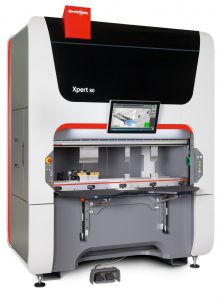Analyzing Current Processes
Taking a closer look at the processes that are implemented in fabricating your products is key to maintaining margins and remaining competitive. Most companies have analyzed and cut their process-related costs, and yours may already be running as lean as possible. Regardless of how diligently a company streamlines processes and employs lean practices, a wall will eventually be reached based on the limitations of their existing equipment and physical infrastructure. This is where technological innovation can be introduced as a solution for managing constantly rising operating expenses.
Reducing Set-up time
One of the most visible bottlenecks will be with the capabilities of your older press brakes. Older press brakes limit the capacity of available bending time due to the increased time that is necessary for their set-up. Less available bending time means fewer parts produced and less capacity for taking on additional work. This bottleneck will be most apparent when you notice a large number of parts that are waiting to be produced at the press brake. The solution could be to just add another brake, but what about finding another qualified operator? What is truly required is a more efficient press brake while not having to increase the number of them. Doing so will not only satisfy your current production capabilities but also satisfy the additional capacity required for future business.
Below is just a small list of the set-up tasks that are either eliminated altogether or reduced to very little time using modern press brake technologies.
- Side-loading of punches
- Shimming of punches and dies
- Changing 4-way dies
- Manual adjustment of back gauges
- Manual adjustment of the crowning table
- Manual adjustment of laser-based safety guarding
- Manual bending of large and or heavy parts
- Programming at the press brake
- Calculating bend deductions
- Making constant bend angle corrections
If you are currently experiencing any of the above, then you are losing available bending time due to increased set-up time. If you were to add up the time for the above and multiply by the number of times that it occurs in a day, times the number of available production days, then you have the total number of hours and money that the additional set-up time is costing you per year.
What is then missing from the justification is the lost business or lost revenue from the loss of available bending time. How much more revenue could be produced utilizing the same number of brakes but with increased capacity for handling additional business opportunities? What about utilizing modern high-speed press brakes that are capable of bending two times more parts per unit of time than older press brakes?
The results are a much lower cost per part, higher throughput capabilities, and additional capacity to take on even more business, all producing higher revenue streams for your business and a clear justification for the modern press brake.
Improvements through Innovation
Innovation is usually at the core of effective processes analysis. The goal of analyzing a process should be to find better, more productive and efficient ways to achieve the desired result, which is another way of saying that it requires innovative thinking. This often involves improving operating procedures. Once these procedural options have been exhausted, the next logical step is to change the physical nature of the process itself.
Almost always, adding innovation to the process involves improvements in technology that make the process easier, faster or less wasteful than before. With increased speed comes the real benefit: less time and cost required to produce the same product. The question then becomes: “What does the new technology cost and what is the return on investment?” Given the unpredictable nature of increasing costs, perhaps the better question might be: “What will be the long-term cost of failing to invest in new production technologies?” How do I lower my cost per part in the face of variability?
The Bottom Line
With a lower quote, how much additional revenue will your company have gained as a result of winning new jobs with a lower estimate? How much more manufacturing capacity will be realized in your equipment by removing unnecessary set-up time and utilizing faster press brakes so additional jobs can be processed? How much more business will your company gain due to the increased customer satisfaction as a result of better quality and faster turnaround times?
By Frank Arteaga, Head of Product Marketing, NAFTA Region
Bystronic Inc., Elgin, IL – Voice.bystronic@bystronic.com

